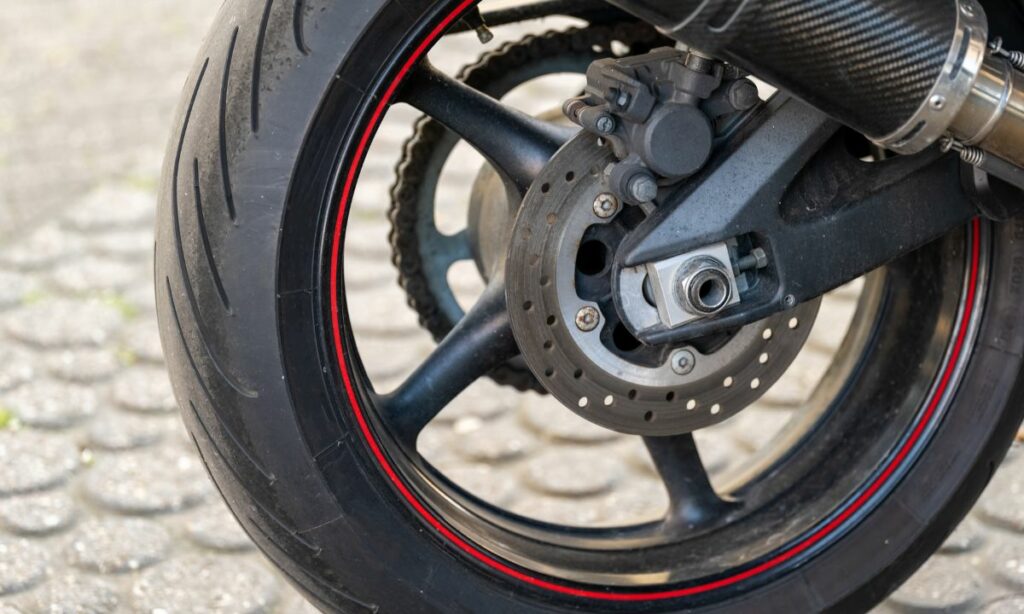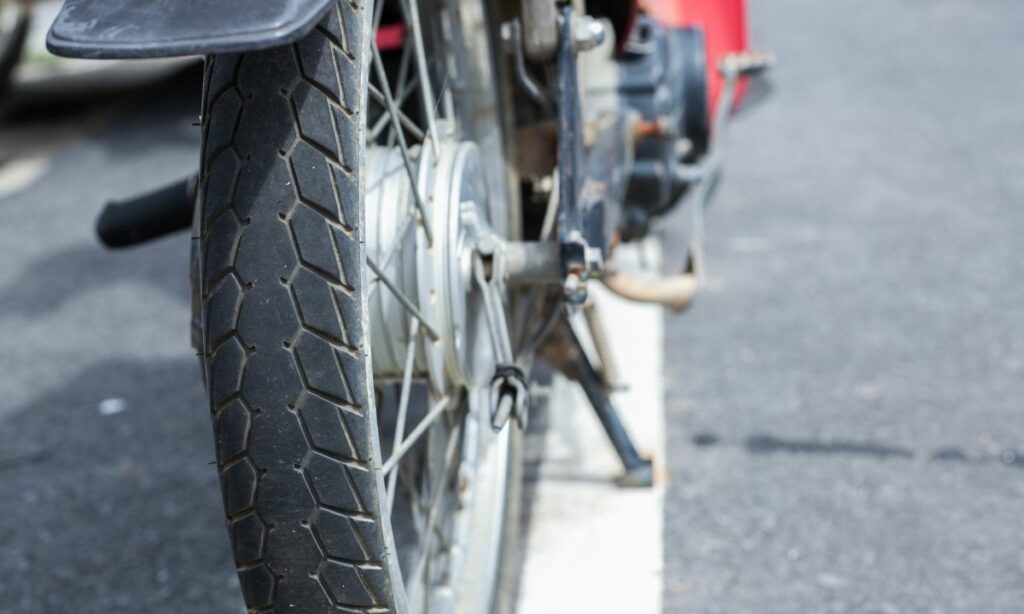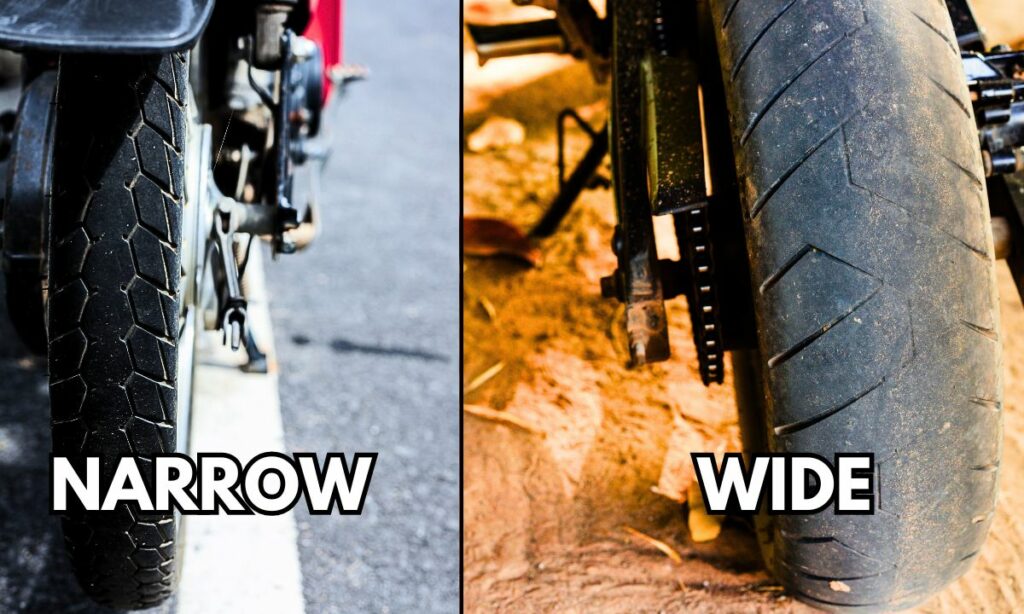Based on the tire width, tires are classified into wide tires and narrow (or skinny) tires.
Now both narrow and wide tires have their advantages. But as a whole, wider tires (not too wide like Hayabusa) are considered better for high performance.
So, wide tires or narrow tires – which is better?
Wide tires are typically considered better since they provide better traction, road grip, speed handling, stability, and braking effectiveness.
Narrow tires do have their advantages like low cost, better fuel economy, and easier maneuverability.
If you want to look at the comparison table, you can directly jump here.
But let’s first see these tires in overview and then go to comparison.
Wide tires
Wide tires provide a better grip. The wider the tire width, the better the grip.
In addition, wide tires also offer better stability, better speed handling, and good brake effectiveness.

But it’s not all roses though. Else we would only see wide tires everywhere.
Wide tires also come with higher weight. Low fuel economy. Requires more power to accelerate.
Personally, I like wide tires. But too wide the tire, motorcycle cornering gets difficult. I have to lean more to make a turn. The same turn with a skinny tire, I would do it easily, the Top Gun style.
So it’s a trade-off. But in general, wide tires are good. Not too wide like Hayabusa of course. A decent wide tire width is optimal.
Most cruisers and heavy-weight motorcycles use wide tires. With their weight and speeding, wide tires are a requirement, to be honest.
Pros
- Better grip and traction
- Higher stability
- Good speed handling, brake effectiveness, and off-roading capabilities
Cons
- Low fuel economy
- Higher weight; requires more power for acceleration
- Higher cost
Narrow tires
Narrow or skinny tires have less tire width.

They are low in weight, provide better fuel economy, and are easier to handle especially while cornering.
Plus, they are cheap too.
Narrow tires work best in performance motorcycles and street bikes.
On the flip side, narrow tires don’t provide road grip as good as wide tires. Too much speeding is not desired since the tire might lose contact with the ground (don’t worry, it’s only for ultra-high speeds).
So, slightly poor speed handling compared to wide tires.
Pros
- Better fuel economy
- Low weight
- Low cost
Cons
- Lower road grip and traction
- Poor stability
- Not the best at high speeds
Comparing wide tires vs narrow tires on different parameters
Here is the comparison table highlighting the differences between the wide and narrow tires. The green colored text indicates better and the red indicates worse on each of these parameters.
| Parameters | Wide Tires | Narrow Tires |
|---|---|---|
| Traction and Road Grip | High | Low |
| Cost | High | Low |
| Maneuvering and Turning | Difficult | Easy |
| Rolling Resistance | High | Low |
| Power Requirements | High | Low |
| Mileage and Fuel Efficiency | Low | High |
| Speed Handling | Easy | Difficult |
| Stability | High | Low |
| Braking Effectiveness | High | Low |
| Cornering Capability | High | Low |
| Off Road Driving | Easy | Difficult |
Road grip and traction
Traction refers to the grip the motorcycle tire has on the road.
The better the traction, the smoother the motorcycle riding for the rider.
If the motorcycle rider loses traction, there is a chance of skidding or falling on the road.
So, which tires have the better traction? Wide tires.
Wide tires provide better traction when compared to skinny or narrow tires.
This is because wide tires have larger surface contact with the road. The traction improves because of the increased contact between the tire and the road.
Cost
Wide tires are costlier than narrow tires.
Narrow tires are a cheaper and more economical alternative when compared to wide tires.
Even motorcycle models that contain wide tires are costlier owing to the additional charge paid by the manufacturer to their tire supplier.
Similarly, replacing a wide tire costs you more than that of a narrow tire.
One of the main reasons why bike manufacturers still use skinny tires provided the motorcycle design allows for a wide tire is because it brings down the total motorcycle cost.
If you want to replace motorcycle tires, be aware that wide tires are going to be costly and narrow tires are going to be cheaper.
Maneuvering and Turning
While wide tires provide you more traction and road grip, narrow tires give you the flexibility to maneuver and turn the motorcycle easily.
When you are riding on topsy-turvy roads or going for a turn or changing lanes, narrow tires on the motorcycle are much easier to handle. The turning and steering are smoother without requiring much effort.
Wide tires, on the other hand, do not provide that flexibility and comfort when turning, maneuvering, steering, or changing the lines.
Rolling Resistance
Rolling resistance refers to the friction resistance that tires face while running on the road freely.
If you speed up the motorcycle and then go into neutral, the tire that comes to a halt faster has higher rolling resistance.
So which one do you think has better rolling resistance?
As expected, wide tires have higher rolling resistance than narrow tires.
The larger surface contact between the wide tire and the road results in higher friction faced by the wide tire. And that’s why they usually have high rolling resistance.
Power Requirements
High rolling resistance demands high power requirements.
The power to move the tire forward by overcoming the rolling friction will automatically be higher in the wide tires.
For that reason, wide tires require higher power than narrow tires if all other things remain the same.
It might not surprise you that wide tires are typically complimented with higher engine capacities.
Mileage and Fuel Economy
Now, this is the main advantage – apart from the low cost – that narrow tires provide.
Since narrow tires have lower rolling resistance and lower power requirements than wide tires, fuel consumption is considerably lower.
When the fuel consumption is lower to achieve the same speed levels as that of a motorcycle with wide tires, naturally skinny tires in a motorcycle provide better mileage and fuel efficiency.
Bottomline, narrow tires provide better mileage and fuel efficiency as compared to wide tires.
Speed handling
Motorcycle handling and steering, especially at higher speed levels are easier with wide tires.
The traction and road grip plays a significant role. Especially at higher speeds.
Since wide tires have better traction and grip, handling a motorcycle with wide tires is far easier during high-speed levels than that of motorcycles with narrow tires.
In other words, the speed handling of motorcycles is smoother with wide tires.
Stability
Wide tires provide far more stability than narrow tires.
If the road is wet due to rain or it is slippery, there will be a high chance of motorcycle skidding.
Wide tires help you in such situations. They reduce skidding chances.
Even if the roads are slippery and wet, the wide tires provide the much-needed stability to prevent any slipping or skidding.
In addition, they help in punctures as well.
If a nail is stuck or the tire goes flat, a wide tire allows you to travel some more time over a narrow tire.
You can take it to a service shop to get the tire plugged or replaced from there.
Narrow tires, unfortunately, do not provide the level of stability that wide tires provide to a motorcycle.
Braking Effectiveness
Compared to narrow tires, motorcycles with wide tires make it easier to apply brakes and halt the bike.
This braking effectiveness is also complimented by braking systems.
Generally, wide tires are used in high cc engine motorcycles. As a result, motorcycles with wide tires most definitely have disc brake systems.
Motorcycles with narrow or skinny tires, on the other hand, are usually found in lower cc engine motorcycles. These motorcycles mostly use drum brake systems in them.
As discussed in this post, the disc braking system has superior functionalities and braking performance than the drum braking system. This factor adds in as well to improve the braking effectiveness of the wide tires when compared to the motorcycles with skinny tires.
Cornering Capability
The wider the tire – the better the cornering capability.
So, wide tires provide better cornering capabilities in a motorcycle when compared to narrow tires. This has to do with superior traction, grip, and larger friction to the contact area that wide tires have.
There is one inconvenience with wide tires during cornering though. The motorcycle rider has to corner more when compared to skinny tires.
Other than that, cornering is much easier with wide tires than with skinny tires.
Off Road Driving
If you drive on muddy paths, on gravel roads, or during the rainy season, the tires play an important role in giving you a smooth riding experience.
Off-road driving is usually better with wide tires. They offer better traction and have higher rolling resistance to prevent skidding of the bike.
Bottomline – which is better?
The better tire is the one your motorcycle manufacturer recommends. Any changes you make don’t add much, to be honest.
Having said that, in general slightly wider tires are considered the optimum tire size for high performance.
That isn’t to say narrow tires are bad though. Fuel efficiency is typically better with narrow/skinny tires.
Before you go…
Here are a few more tires and wheels posts for you:
